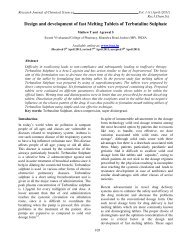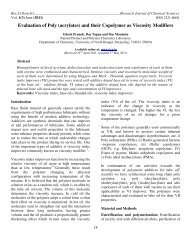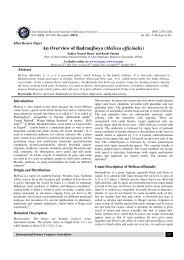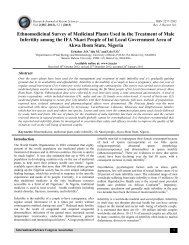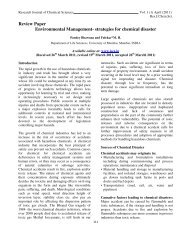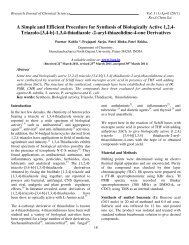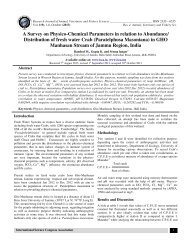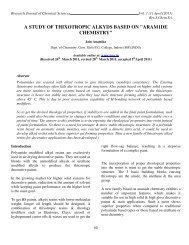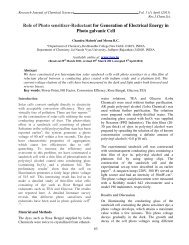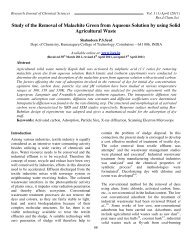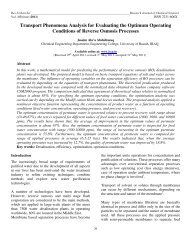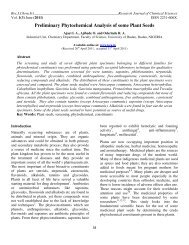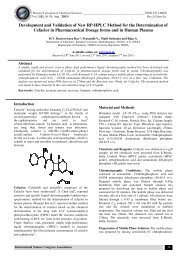Effect of Micro Silica on The Strength of Concrete with ... - ISCA
Effect of Micro Silica on The Strength of Concrete with ... - ISCA
Effect of Micro Silica on The Strength of Concrete with ... - ISCA
You also want an ePaper? Increase the reach of your titles
YUMPU automatically turns print PDFs into web optimized ePapers that Google loves.
Research Journal <str<strong>on</strong>g>of</str<strong>on</strong>g> Engineering Sciences________________________________________________________ ISSN 2278 – 9472<br />
Vol. 1(3), 1-4, Sept. (2012)<br />
Res. J. Engineering Sci.<br />
produced. Its unit weight usually varies from 130 to 430 kg/mᶾ.<br />
<strong>The</strong> specific gravity <str<strong>on</strong>g>of</str<strong>on</strong>g> silica fume is generally in the range <str<strong>on</strong>g>of</str<strong>on</strong>g><br />
2.20 to 2.5. In order to measure the specific surface area <str<strong>on</strong>g>of</str<strong>on</strong>g><br />
silica fume a specialized test called the “BET method” or<br />
nitrogen adsorpti<strong>on</strong> method must be used. Based <strong>on</strong> this test the<br />
specific surface <str<strong>on</strong>g>of</str<strong>on</strong>g> silica fume typically ranges from 15,000 to<br />
30,000 mᶾ/kg.<br />
Mechanism: <str<strong>on</strong>g>Silica</str<strong>on</strong>g> fume improves c<strong>on</strong>crete through two<br />
mechanisms:<br />
Pozzol<strong>on</strong>ic effect: When water is added to cement, hydrati<strong>on</strong><br />
occurs forming two products, as shown below:<br />
OPC + H2O →CSH (Calcium silicate hydrate) + Ca(OH)2.<br />
In thepresence <str<strong>on</strong>g>of</str<strong>on</strong>g> SF, the silic<strong>on</strong> dioxide from the ORISIL SF<br />
will react <strong>with</strong> the calcium hydroxide to produce more<br />
aggregate binding CSH as follows:<br />
Ca(OH) 2 + SiO 2 → H 2 O +CSH.<br />
<strong>The</strong> reacti<strong>on</strong> reduces the amount <str<strong>on</strong>g>of</str<strong>on</strong>g> calcium hydroxide in the<br />
c<strong>on</strong>crete. <strong>The</strong> weaker calcium hydroxide does not c<strong>on</strong>tribute to<br />
strength. When combined <strong>with</strong> carb<strong>on</strong> dioxide, it forms a<br />
soluble salt, which will leach through the c<strong>on</strong>crete causing<br />
efflorescence, a familiar architectural problem. C<strong>on</strong>crete is also<br />
more vulnerable to sulphate attack, chemical attack and adverse<br />
alkali-aggregate reacti<strong>on</strong>s when high amounts <str<strong>on</strong>g>of</str<strong>on</strong>g> calcium<br />
hydroxide is present in c<strong>on</strong>crete 2 .<br />
<str<strong>on</strong>g>Micro</str<strong>on</strong>g> filler effect: <str<strong>on</strong>g>Silica</str<strong>on</strong>g> Fume is an extremely fine material,<br />
<strong>with</strong> an average diameter 100 times finer than cement. At a<br />
typical dosage <str<strong>on</strong>g>of</str<strong>on</strong>g> 8% by weight <str<strong>on</strong>g>of</str<strong>on</strong>g> cement, approximately<br />
100,000 particles for each grain <str<strong>on</strong>g>of</str<strong>on</strong>g> cement will fill the water<br />
spaces in fresh c<strong>on</strong>crete. This eliminates bleed and the weak<br />
transiti<strong>on</strong> z<strong>on</strong>e between aggregate and paste found in normal<br />
c<strong>on</strong>crete. This micro filler effect greatly reduces permeability<br />
and improves paste-to aggregate b<strong>on</strong>d in SF c<strong>on</strong>crete compared<br />
to c<strong>on</strong>venti<strong>on</strong>al c<strong>on</strong>crete 3 . <strong>The</strong> silica fume reacts rapidly<br />
providing high early strength and durability. <strong>The</strong> efficiency <str<strong>on</strong>g>of</str<strong>on</strong>g><br />
silica fume is 3-5 times that <str<strong>on</strong>g>of</str<strong>on</strong>g> OPC and c<strong>on</strong>sequently c<strong>on</strong>crete<br />
performance can be improved drastically 4 .<br />
Cement: Cement is made by heating limest<strong>on</strong>e (calcium<br />
carb<strong>on</strong>ate) <strong>with</strong> small quantities <str<strong>on</strong>g>of</str<strong>on</strong>g> other materials (such as clay)<br />
to 1450°C in a kiln, in a process known as calcinati<strong>on</strong>, where by<br />
a molecule <str<strong>on</strong>g>of</str<strong>on</strong>g> carb<strong>on</strong> dioxide is liberated from the calcium<br />
carb<strong>on</strong>ate to form calcium oxide, or quicklime, which is then<br />
blended <strong>with</strong> the other materials that have been included in the<br />
mix. <strong>The</strong> resulting hard substance, called 'clinker', is then<br />
ground <strong>with</strong> a small amount <str<strong>on</strong>g>of</str<strong>on</strong>g> gypsum into a powder to make<br />
'ordinary portland cement', the most comm<strong>on</strong>ly used type <str<strong>on</strong>g>of</str<strong>on</strong>g><br />
cement (<str<strong>on</strong>g>of</str<strong>on</strong>g>ten referred to as OPC) 2 . Portland cement is a basic<br />
ingredient <str<strong>on</strong>g>of</str<strong>on</strong>g> c<strong>on</strong>crete, mortar and most n<strong>on</strong>-specialty grout. <strong>The</strong><br />
most comm<strong>on</strong> use for portland cement is in the producti<strong>on</strong> <str<strong>on</strong>g>of</str<strong>on</strong>g><br />
c<strong>on</strong>crete. C<strong>on</strong>crete is a composite material c<strong>on</strong>sisting <str<strong>on</strong>g>of</str<strong>on</strong>g><br />
aggregate (gravel and sand), cement, and water. As a<br />
c<strong>on</strong>structi<strong>on</strong> material, c<strong>on</strong>crete can be cast in almost any shape<br />
desired, and <strong>on</strong>ce hardened, can become a structural (load<br />
bearing) element. Portland cement may be grey or white.<br />
pozzolanic cement is a blend <str<strong>on</strong>g>of</str<strong>on</strong>g> OPC and another compound<br />
usually fly ash ordinary portland cement (OPC) has a property<br />
<str<strong>on</strong>g>of</str<strong>on</strong>g> hydraulic setting, binding and hardening when mixed <strong>with</strong><br />
water. Some materials undergo hydraulic setting when<br />
combined <strong>with</strong> water in presence <str<strong>on</strong>g>of</str<strong>on</strong>g> cements, but not by itself.<br />
<strong>The</strong>se are called pozzolanic materials. In other words,<br />
pozzolanic material + water do not set. Pozzolanic material +<br />
water + cement sets. Examples <str<strong>on</strong>g>of</str<strong>on</strong>g> pozzolanic materials are fly<br />
ash, blast furnace slag, brick powder (surkhi), rice husk ash etc.<br />
Commercial cement formed by mixing proporti<strong>on</strong>s <str<strong>on</strong>g>of</str<strong>on</strong>g> OPC and<br />
any pozzolaanic material, is called pozzolanic portland cement<br />
PPC. PPC can be made as good, durable and str<strong>on</strong>g as OPC <strong>with</strong><br />
proper mixing ratio. It is generally slow setting and sulphate<br />
resistant. Moreover, it is envir<strong>on</strong>ment friendly serving to recycle<br />
waste products such as fly ash and slag. i. OPC – Ordinary<br />
ortland cement, ii. OPC is obtained by adding raw materials like<br />
calcareous materials and argillaceous materials, iii. PPC -<br />
portland pozzol<strong>on</strong>a cement, iv. PPC is obtained by adding<br />
pozzol<strong>on</strong>ic materials like flyash, pumicites, volcanic ashes,<br />
shales, tuffs, etc.<br />
Experimental Details: <strong>The</strong> following materials were used for<br />
experiment, ordinary portland cement c<strong>on</strong>forming to IS 456-<br />
2000 graded fine aggregates local clean river sand.<br />
Graded coarse aggregates: locally available well graded<br />
aggregates <str<strong>on</strong>g>of</str<strong>on</strong>g> normal size greater than 4.75 mm and less than<br />
10mm having a fineness modulus <str<strong>on</strong>g>of</str<strong>on</strong>g> 2.72.<br />
Table-1<br />
<strong>The</strong> basic comp<strong>on</strong>ents <str<strong>on</strong>g>of</str<strong>on</strong>g> cement<br />
SiO 2 17-25 %<br />
Al 2 O 3 4-8%<br />
Fe 2 O 3 0.5-0.6 %<br />
CaO 61-63 %<br />
MgO 0.1-4.0 %<br />
SO 3 1.3-3.0 %<br />
Na 2 + K 2 O 0.4-1.3 %<br />
Cl 0.01-0.1%<br />
IR 0.6-1.75 %<br />
Results and Discussi<strong>on</strong><br />
150x150x150 mm c<strong>on</strong>crete cubes were cast using 1:1.5:3 mix<br />
proporti<strong>on</strong> <strong>with</strong> w/c ratio <str<strong>on</strong>g>of</str<strong>on</strong>g> 0.50 Specimen <strong>with</strong> ordinary<br />
portland cement and ordinary portland cement <strong>with</strong> various<br />
silica fume level 0%, 5%, 10%, 15% were cast 5 . During<br />
moulding the cubes were mechanically vibrated after moulding<br />
the c<strong>on</strong>crete blocks were demoulded and subjected to curing in<br />
water for 7days, 14days 28days. <strong>The</strong> specimen were tested for<br />
compressive strength using a compressi<strong>on</strong> testing machine <str<strong>on</strong>g>of</str<strong>on</strong>g><br />
200 KN capacity 6 . Compressive strength in N/m 2<br />
Internati<strong>on</strong>al Science C<strong>on</strong>gress Associati<strong>on</strong> 2



